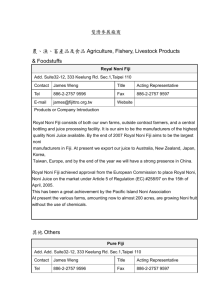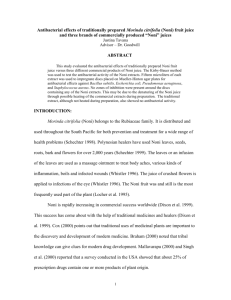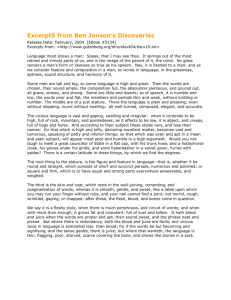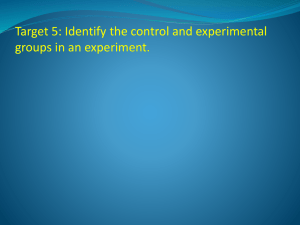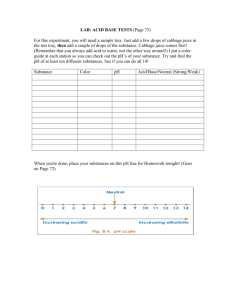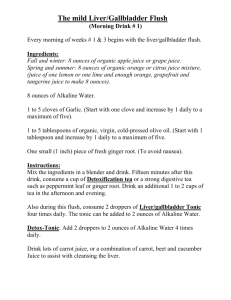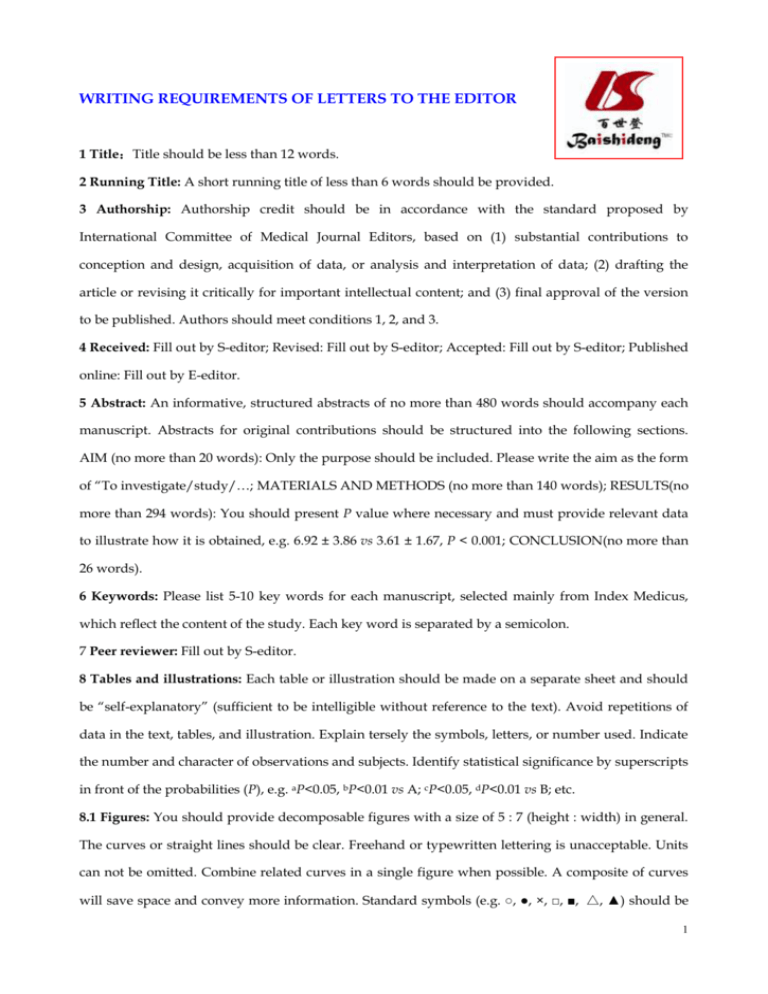
WRITING REQUIREMENTS OF LETTERS TO THE EDITOR
1 Title:Title should be less than 12 words.
2 Running Title: A short running title of less than 6 words should be provided.
3 Authorship: Authorship credit should be in accordance with the standard proposed by
International Committee of Medical Journal Editors, based on (1) substantial contributions to
conception and design, acquisition of data, or analysis and interpretation of data; (2) drafting the
article or revising it critically for important intellectual content; and (3) final approval of the version
to be published. Authors should meet conditions 1, 2, and 3.
4 Received: Fill out by S-editor; Revised: Fill out by S-editor; Accepted: Fill out by S-editor; Published
online: Fill out by E-editor.
5 Abstract: An informative, structured abstracts of no more than 480 words should accompany each
manuscript. Abstracts for original contributions should be structured into the following sections.
AIM (no more than 20 words): Only the purpose should be included. Please write the aim as the form
of “To investigate/study/…; MATERIALS AND METHODS (no more than 140 words); RESULTS(no
more than 294 words): You should present P value where necessary and must provide relevant data
to illustrate how it is obtained, e.g. 6.92 ± 3.86 vs 3.61 ± 1.67, P < 0.001; CONCLUSION(no more than
26 words).
6 Keywords: Please list 5-10 key words for each manuscript, selected mainly from Index Medicus,
which reflect the content of the study. Each key word is separated by a semicolon.
7 Peer reviewer: Fill out by S-editor.
8 Tables and illustrations: Each table or illustration should be made on a separate sheet and should
be “self-explanatory” (sufficient to be intelligible without reference to the text). Avoid repetitions of
data in the text, tables, and illustration. Explain tersely the symbols, letters, or number used. Indicate
the number and character of observations and subjects. Identify statistical significance by superscripts
in front of the probabilities (P), e.g. aP<0.05, bP<0.01 vs A; cP<0.05, dP<0.01 vs B; etc.
8.1 Figures: You should provide decomposable figures with a size of 5 : 7 (height : width) in general.
The curves or straight lines should be clear. Freehand or typewritten lettering is unacceptable. Units
can not be omitted. Combine related curves in a single figure when possible. A composite of curves
will save space and convey more information. Standard symbols (e.g. ○, ●, ×, □, ■, △, ▲) should be
1
used when there are multiple curves.
8.2 Photographs, Images and Legends
8.2.1 The photographs supplied should be no smaller than 85 mm in height and 126 mm in width,
and at a resolution of 300 dpi as TIFF format. The colour photos should be saved in TIFF format at a
resolution of 300 dpi; each photo in a separate file, and no smaller than 86 mm × 50mm.
8.2.2 Images submitted should be those which uniquely display the data. Figures are not limited, but
must be thoroughly justified. For figures that have multiple panels, the labels should be set in
uppercase Helvetica or Arial letters and should not contain periods or parentheses. Please be sure to
embed all fonts. Micrographs should be provided with a scale bar, if appropriate, instead of
magnification. Figures should be should be either Photoshop or Illustrator files (in tiff, psd, eps, ai,
pdf, or JPEG formats) at 300 dpi resolution (for a figure no smaller than 50 mm in height and 86 mm
in width). Our professional in-house illustrator will work with authors to ensure the highest quality
and clarity of published figures. Please provide only one legend for each photo or figure that contains
all the pertinent information. Figures or photos should be grouped according to their themes. For
example, Figure 1 Pathological changes of atrophic gastritis tissue before and after treatment. A: …;
B: …; C: …; D: …; E: …; F: …. Explain the symbols, arrows, numbers, or letters in the illustrations.
Identify the method of staining and magnification of the photomicrographs (eg, HE stain, ×900). For
those including methodology, the legend should be no more than 100 words (no more than 500
words in total). For those not including methodology, the legend should be no more than 300 words
(no more than 800 words in total). Letters in photos or figures should be lowercased while the first
one be capitalized. An interval should be inserted between numbers and units. Photos or figures that
are obtained at different time or places must not be grouped into one, unless those photos or figures
are arranged in a time order. There are intervals between photos or figures of the same group.
Photographs or figures should be put in an independent file.
8.2.3 Authors should list the names of tools they use to obtain and edit the image file. Images must be
edited equally and contrast must be reasonable. Editing that is far beyond the contents is forbidden. It
is not allowed to over-emphasize the difference between experiment data and control data, or
over-emphasize a certain part of the photos by ignoring some other parts. (A) Electrophoresis and
blotting images: must include negative, positive controls and molecular Marker; provide the
reference of the identified antibodies; explain the specificity and active spectrum of the agents not
2
identified; band should be clear; important bands must not be deleted; leave six-band space around
the blotting bands; we suggest not use high-contrast blotting, for over-display may conceal the other
bands. Authors should try to exhibit the bands on the gray background. Black frame may be used if
the background is weak. (B) Microscopic or endoscopic images: cells from different field must not be
put in the same field; images should be adjusted at a whole; avoid pseudo-color and nonlinear
adjustment (e.g. γ transformation), and give an explanation in the legend if necessary.
8.3 Tables: A decomposable table is required. Each table should be put in an independent page, with
a bold title no more than a row long. Tables should be put at the end of the article.
9 References: Pleased provide PubMed citation numbers to the reference list, e.g. PMID and DOI,
which
can
be
found
at
http://www.ncbi.nlm.nih.gov/sites/entrez?db=pubmed
and
http://www.crossref.org/SimpleTextQuery/, respectively. The numbers will be used in E-version of
this journal. Thanks very much for your co-operation.
10 S- Editor, L- Editor and E- Editor: Fill out by responsible person.
3
Format for LETTERS TO THE EDITOR
LETTERS TO THE
Ms. wjg/2009/000000
EDITOR
Noni juice is not hepatotoxic
West BJ et al. Noni juice is not hepatotoxic
Brett J West, C Jarakae Jensen, Johannes Westendorf
Brett J West, C Jarakae Jensen, Research and Development Department, Tahitian Noni
International, American Fork, Utah, United States
Johannes Westendorf, University Medical School of Hamburg, Department of
Toxicology, Hamburg, Germany
Author contributions:
Supported by
Correspondence to: Brett J West, Research and Development, Tahitian Noni
International, American Fork, UT 84003, United States. brett_west@tni.com
Telephone: +1-801-2343621 Fax: +1-801-2341030
Received:
Revised:
Accepted:
Published online:
4
Abstract
Noni juice (Morinda citrifolia) has been approved for use as a safe food within the
European Union, following a review of safety. Since approval, three cases of acute
hepatitis in Austrian noni juice consumers have been published, where a causal link is
suggested between the liver dysfunction and ingestion of anthraquinones from the plant.
Measurements of liver function in a human clinical safety study of TAHITIAN NONI®
Juice, as well as subacute and subchronic animal toxicity tests revealed no evidence of
adverse liver effects at doses many times higher than those reported in the case studies.
Additionally, M. citrifolia anthraquinones occur in the fruit in quantities too small to be
of any toxicological significance. Further, these do not have chemical structures capable
of being reduced to reactive anthrone radicals, which were implicated in previous cases
of herbal hepototoxicity. The available data reveals no evidence of liver toxicity.
© 2006 The WJG Press. All rights reserved.
Key words: Noni juice; Morinda citrifolia; Novel food; Human clinical safety study
Peer reviewer:
West BJ, Jensen CJ, Westendorf J. Noni juice is not hepatotoxic. World J Gastroenterol
2006; 12(22): 3616-3619
Available from: URL: http://www.wjgnet.com/1007-9327/12/0000.asp
DOI: http://dx.doi.org/10.3748/wjg.12.0000
5
TO THE EDITOR
Morinda citrifolia (noni) fruit juice was approved as a novel food ingredient in
pasteurized fruit drinks by the European Commission Decision of 05-06-2003. This
approval was based on the opinion of the EU Scientific Committee on Food (SCF) of
Tahitian Noni® Juice, following a safety review of this product[1].
During 2004, an Austrian case report was published in which it is suggested that noni
fruit juice may be responsible for acute hepatitis[2]. A second report was published in the
August 2005 issue of this journal in which noni juice was again suggested to be the cause
of two other cases of acute hepatitis in Austria[3]. In both publications, the authors
suggest the presence of anthraquinones in the juice may be responsible for the liver
dysfunction observed in their patients. However, experimental data fails to reveal any
direct liver toxicity from noni juice.
TAHITIAN NONI® Juice, the brand associated with the latest case reports, was
investigated in a human clinical study (unpublished data. Mugglestone C et al. A single
centre, double-blind, three dose level, parallel group, placebo controlled safety study
with TAHITIAN NONI® Juice in healthy subjects, BIBRA International Ltd. UK, 2003).
Ninety-six subjects were randomly assigned to four groups. These groups included a
placebo group and three test groups, receiving up to a dose of 750 mL TAHITIAN
NONI® Juice per day. For 28 d, subjects drank 750 mL of either the placebo or juice
containing one of three doses of TAHITIAN NONI® Juice.
Several parameters were investigated with measure-ments being made at study
screening, d 0 (baseline), wk 2, wk 4, and wk 6. The measurements most applicable to the
evaluation of liver function and hepatocellular disease were alkaline phosphatase (ALP),
alanine aminotransferase (ALT), aspartate aminotransferase (AST), total bilirubin (BIL),
gamma-glutamyl transferase (GGT), total protein, and prothrombin time (which is
useful for determining the extent of hepatocellular disease).
Other study measurements included hemoglobin, hematocrit, mean cell volume, red
cell count, activated partial thrombin time, total and differential white cell count, platelet
6
count, lipids (LDL, HDL, cholesterol, triglycerides), creatine kinase, creatinine,
gamma-glutamyl transferase, glucose, total protein, and uric acid. Additionally,
urinalysis involved semi-quantitative ("dipstick") analysis for leucocytes, nitrite,
urobilinogen, protein, pH, blood, specific gravity, ketones, bilirubin and glucose. Where
necessary, a urine cyto-bacteriological examination was performed to characterize or
count crystals, casts, epithelial cells, white blood cells, red blood cells and bacteria. Vital
signs were measured, including systolic and diastolic blood pressure and heart rate.
ECG measurements (12 lead) were also made for each subject. All adverse events were
recorded. Selected mean laboratory values for the various groups are presented in Table
1.
Differences between mean values were clinically insignificant and well within the
range of normal values. Furthermore, there was no evidence of any dose-related adverse
events. The study results indicate that TAHITIAN NONI® Juice is safe to consume, in
quantities up to 750 mL/d, confirming the EU SCF opinion that high consumption
quantities are appropriate.
The aqueous extract of M. citrifolia fruit was evaluated in a repeat dose oral toxicity
assay in rats[4]. For 28 d, Sprague Dawley rats received 1000 mg/kg body weight.
Animals were observed for clinical symptoms, body weight was recorded, and
hematology and serum chemistry parameters were measured.
Among the serum chemistry measurements were AST, ALT, and GGT. There were no
significant differences between the males and females of the test and control groups,
with the exception of a lower AST value observed in the females of the treatment group,
and an exceptionally low ALT value for the males of the control group that resulted in a
statistical difference for treated males. In either instance, however, the values observed
in the treatment groups were within the normal range for these animals and did not
correspond to a dose-response relationship. These results did not reveal any adverse
liver effects.
Two 13-wk oral toxicity studies of TAHITIAN NONI® Juice in rats were performed
(unpublished data, Glerup P. TAHITIAN NONI® Juice-A 13-wk oral (gavage) toxicity
study in rats. Scantox Biologisk Laboratorium, Lille Skensved, Denmark, Lab no. 35 207,
7
March 2000; and Glerup P. TAHITIAN NONI® Juice-A 13-wk oral (gavage) toxicity
study in rats. Scantox Biologisk Laboratorium, Lille Skensved, Denmark, Lab no. 39 978,
May 2001). In each study, 80 Sprague Dawley rats (40 males and 40 females) were
included. Six consecutively higher doses were examined in each study, with a high dose
equivalent to 80 mL TAHITIAN NONI® Juice/kg per day (20 mL/kg of 4-fold
concentrated juice).
Study measurements indicative of liver effects were ALT, AST, ALP, GGT, total
bilirubin, total protein, protein by electrophoresis, globulins, albumin/globulin ratio,
and prothrombin time. Additionally, clinical observations included liver weights, and
macroscopic and microscopic (histological) examination of the livers. Laboratory data
for liver function for each dose group in each study are mentioned in Tables 2, 3, 4, and
5.
No treatment-related changes were observed in any of the dose groups for any of
these measurements, including histological examinations, demonstrating a lack of
toxicity to the liver. Consequently, the No Observable Adverse Effect Level (NOAEL)
was determined to be greater than 80 mL TAHITIAN NONI Juice/kg per day.
The NOAEL is much higher than the amounts ingested by the patients described in
the case studies. In the most recent publication, the first patient consumed a daily dose
of 71.4 mL (1.5 L consumed over 3 wk). The second case reported in this publication
describes a daily consumption rate of 23.8 mL (2 L consumed over 3 mo). The weight of
each patient is not given, but assuming an average weight of 70 kg, the doses consumed
would be 1.02 mL/kg per day and 0.34 mL/kg per day. The NOAEL of the animal
studies is almost 80 times greater than these two doses. The high dose in the clinical
study was approximately 10 times higher.
The first published case report claims that the patient drank a glass of noni juice every
day for a few weeks. No exact quantity is specified; no indication is given as to how
large the glass was or how much of it was filled. However, assuming a full cup volume
of 250 mL and a patient weight of 70 kg, the dose would be 3.6 mL/kg. The NOAEL of
the animal studies is 22 times greater than the ingestion rate of this patient, and the
clinical study high dose is three times more. Not only are all reported doses in these
8
cases well within the highest doses of the controlled studies, where no liver effects were
observed, but were also sufficiently low to assume a large margin of safety. If there is
any true causal link, it is likely to be only idiosyncratic in nature.
As a pretext for implicating noni juice in liver toxicity, the authors of both reports cite
publications containing only limited information, including similar case reports for the
herbal laxative drugs Senna (Cassia augustifolia)[5] and Cascara sagrada (Rhamnus
purshianus)[6]. The laxative effects of these herbal preparations are due to large
quantities of a specific class of anthraquinones[7] (different than those in the noni plant).
In these cases, the patients had ingested large quantities of the herbs for an extensive
time.
Consequently,
the
investigators
propose
a
potential
involvement
of
anthraquinones. A similar assumption is made in the few case reports of other herbs
cited by the authors of these two publications[8-10]. In these instances, however, the role
of the anthraquinones directly isolated from these herbs, and linked to the patients' liver
dysfunction was not supported by any additional experimental evidence. In fact,
support for these assumptions is based on limited information from experimental
studies of sennosides[11] and luteoskyrin[12] , which do not occur in the noni plant.
The suggestion of an anthraquinone involvement in the three Austrian cases is not
based on solid data. The first argument against such a causal link is a quantitative one.
Until very recently, investigators had been unable to identify or isolate anthraquinones
from noni fruit[13]. However, two recent publications have reported the presence of
anthraquinones in noni fruit, at very low concentrations. The first report describes 48.3
mg of isolated material, distributed amongst six anthraquinones, from 1.3 kg of dried
noni fruit from Indonesia[14]. On a dry weight basis, the total concentration is 37 × 10-6.
In the juice form, the concentration would be approximately 3×10-6. The second
publication describes isolating a few micrograms of anthraquinones from 9 kg of dried
fruit[15]. The anthraquinone concentration in this study was less than 1 × 10-6. Such low
yields and concentrations are responsible for the inability of earlier researchers to
identify anthraquinones in the fruit.
In comparison to Senna and Cascara sagrada, the total anthraquinone content of noni
fruit is insignificant. The European Pharmacopoeia describes Senna leaf as containing no
9
less than 2.5% (25 × 10-3) anthraquinones; the standardized extract is to contain no less
than 5.5%. Cascara sagrada is described as having a minimum anthra-quinone content of
8% (80 × 10-3). These concentrations are many thousands of times higher than that in
noni juice. Where a large quantity of Senna and Cascara is required to induce liver
toxicity, it is unreasonable to assume a barely detectable quantity of anthraquinones in
noni juice can have the same effect.
Beyond the minute quantity of anthraquinones in noni fruit juice is a second issue of
chemical structure. Anthraquinones do not have the same universal biological effects.
Differences in bioactivities, toxic or otherwise, are seen amongst variants of other types
of compounds as well. Thus, it is not reasonable to assume that one category of
anthraquinones will have the same exact toxic action as another. The anthraquinones
present in the laxative herbs, linked to the previous cases of hepatotoxicity, are 1,
8-dihydroxyanthraquinones (1, 8-DHA’s). On the other hand, those that occur in M.
citrifolia are substituted 9, 10-anthraquinones[16,17]. These structural differences result in
different modes of action. The 9, 10-anthraquinones can not be reduced in biological
systems to form anthrone radicals, while 1, 8-DHA’s can[18]. It is the formation of
anthrone radicals that is required to produce tissue damage[19].
In summary, human and animal studies of high doses of TAHITIAN NONI ® Juice
reveal no adverse liver effects. Further, anthraquinones in noni fruit are of insufficient
quantities and fail to possess the necessary chemical structures to cause liver tissue
damage. The available data demonstrates that noni juice is not directly toxic to the liver
10
REFERENCES
1
2
3
4
5
6
7
8
9
10
11
12
13
14
Scientific Committee on Food. Opinion of the Scientific Committee on Food on Tahitian Noni®
Juice. SCF/CS/NF/DOS/18 ADD 2 Final. 11 Dec. 2002. Available from: URL:
http://europa.eu.int/comm/food/fs/sc/scf/out151_en.pdf
Millonig G, Stadlmann S, Vogel W. Herbal hepatotoxicity: acute hepatitis caused by a Noni
preparation (Morinda citrifolia). Eur J Gastroenterol Hepatol 2005; 17: 445-447
doi:10.1097/00042737-200504000-00009
Stadlbauer V, Fickert P, Lackner C, Schmerlaib J, Krisper P, Trauner M, Stauber RE.
Hepatotoxicity of NONI juice: report of two cases. World J Gastroenterol 2005; 11: 4758-4760
Mancebo A, Scull I, Gonzales Y, Arteaga ME, Gonzales BO, Fuentes D, Hernandez O. Correa M.
Ensayo de toxicidad a dosis repetidas (28 dias) por via oral del extracto acuoso de Morinda
citrifolia en ratas Sprague Dawley. Rev Toxicol 2002; 19: 74-78
Beuers U, Spengler U, Pape GR. Hepatitis after chronic abuse of senna. Lancet 1991; 337: 372-372
doi:10.1016/0140-6736(91)91012-J
Nadir A, Reddy D, Van Thiel DH. Cascara sagrada-induced intrahepatic cholestasis causing
portal hypertension: case report and review of herbal hepatotoxicity. Am J Gastroenterol 2000; 95:
3634-3637 doi:10.1111/j.1572-0241.2000.03386.x PMid:11151906
De Smet PAGM, Keller K, Hänsel R, Chandler RF. Adverse effects of herbal drugs. Berlin:
Springer-Verlag, 1993:105-139
Li FK, Lai CK, Poon WT, Chan AY, Chan KW, Tse KC, Chan TM, Lai KN. Aggravation of
non-steroidal anti-inflammatory drug-induced hepatitis and acute renal failure by slimming drug
containing
anthraquinones.
Nephrol
Dial
Transplant
2004;
19:
1916-1917
doi:10.1093/ndt/gfh151
Park GJ, Mann SP, Ngu MC. Acute hepatitis induced by Shou-Wu-Pian, a herbal product derived
from
Polygonum
multiflorum.
J
Gastroenterol
Hepatol
2001;
16:
115-117
doi:10.1046/j.1440-1746.2001.02309.x PMid:11206309
Itoh S, Marutani K, Nishijima T, Matsuo S, Itabashi M. Liver injuries induced by herbal medicine,
syo-saiko-to (xiao-chai-hu-tang). Dig Dis Sci 1995; 40: 1845-1848 doi:10.1007/BF02212712
PMid:7648990
Mengs U. Toxic effects of sennosides in laboratory animals and in vitro. Pharmacology 1988; 36
Suppl 1: 180-187 PubMed doi:10.1159/000138438 PMid:3368517
Ueno I, Sekijima M, Hoshino M, Ohya-Nishiguchi H, Ueno Y. Spin-trapping and direct EPR
investigations on the hepatotoxic and hepatocarcinogenic actions of luteoskyrin, an anthraquinoid
mycotoxin produced by Penicillium islandicum Sopp. Generations of superoxide anion and
luteoskyrin semiquinone radical in the redox systems consisted of luteo-skyrin and liver NADPHor NADH-dependent reductases. Free Radic Res 1995; 23: 41-50 doi:10.3109/10715769509064018
PMid:7647918
Zenk MH, el-Shagi H, Schulte U. Anthraquinone production by cell suspension cultures of
Morinda citrifolia. Planta Med 1975; Suppl: 79-101
Kamiya K, Tanaka Y, Endang H, Umar M, Satake T. New anthraquinone and iridoid from the
fruits of Morinda citrifolia. Chem Pharm Bull (Tokyo) 2005; 53: 1597-1599
11
15
16
17
18
19
doi:10.1248/cpb.53.1597
Pawlus AD, Su BN, Keller WJ, Kinghorn AD. An anthraquinone with potent quinone
reductase-inducing activity and other constituents of the fruits of Morinda citrifolia (noni). J Nat
Prod 2005; 68: 1720-1722 doi:10.1021/np050383k PMid:16378361
Thomson RH. Naturally occurring quinones III, Recent ad-vances. London: Chapman and Hall,
1987: 347-606
Leistner E, Zenk MH. Incorporation of shikimic acid into 1,2-dihydroxyanthraquinone (alizarin)
by Rubia tinctorum L.Tetrahedron Letters 1967; 6: 475-476 doi:10.1016/S0040-4039(00)90972-9
Westendorf J. Pharmakologische und toxikologische Bewertung von Anthranoiden.
Pharmazeutische Zeitung 1993; 48: 9-20
Cudlin J, Steinerova N, Sedmera P, Vokoun J. Microbial analogy of Bayer-Villiger reaction with
anthraquinone derivative. Collect Czech Chem Comm 1978; 43: 1908-1910
S-Editor
L-Editor E-Editor
12
Table 1 Mean clinical laboratory values by week and dose groups
Parameter
Value
Placebo
30mL TNJ
300mL TNJ
750mL TNJ
Alkaline
Mean week 0
61.67
58.65
54.00
54.44
phosphatase
Mean week 2
55.80
57.83
51.16
54.47
(U/l)
Mean week 4
63.56
59.48
54.99
53.07
Mean week 6
62.69
61.50
58.22
55.04
Alanine
Mean week 0
17.80
18.00
17.88
21.98
aminotransferase
Mean week 2
18.53
19.53
17.80
24.11
(U/l)
Mean week 4
18.99
20.10
17.75
22.71
Mean week 6
19.21
16.90
17.63
20.92
Aspartate
Mean week 0
18.30
18.55
18.27
20.71
aminotransferase
Mean week 2
18.04
19.67
19.18
22.32
(U/l)
Mean week 4
18.93
19.55
19.19
20.90
Mean week 6
18.42
18.95
18.64
19.87
Total bilirubin
Mean week 0
12.12
10.55
10.93
11.30
(μmol/l)
Mean week 2
13.19
11.31
11.47
14.20
Mean week 4
12.23
11.63
12.07
14.03
Mean week 6
14.77
11.99
11.44
13.98
gamma-Glutamyl
Mean week 0
20.31
24.74
22.51
21.36
transferase (U/l)
Mean week 2
21.19
26.74
23.03
20.99
Mean week 4
21.87
26.54
21.14
21.21
Mean week 6
21.11
24.22
20.00
21.07
13
Table 2 Serum values in female Sprague Dawley rats in 1st 13-wk study (mean ± SD)
Females
Dose
control
0.4 ml/kg
4 ml/kg
8 ml/kg
ALAT(µkat/l)
Mean
SD
2.1
0.5
1.89
0.62
1.98
0.34
1.94
0.33
ASAT(µkat/l)
Mean SD
2.26
0.46
2.15
0.81
1.99
0.39
1.74
0.18
ALKPH(µkat/l)
Mean
SD
2.07
0.27
2.22
0.29
2.08
0.41
2.3
0.45
BILI(µmol/l)
Mean SD
1.21 0.61
1.43 0.52
1.36 0.54
1.22 0.63
GGT(µkat/l)
Mean SD
0.02 0.01
0.01 0.01
0.01
0
0.01
0
14
Table 3 Serum values in male Sprague Dawley rats in 1st 13-wk study (mean ± SD)
Males
Dose
control
0.4 ml/kg
4 ml/kg
8 ml/kg
ALAT(µkat/l)
Mean
SD
2.47
0.42
2.27
0.52
2.35
0.44
2.4
0.61
ASAT(µkat/l)
Mean SD
2.11
0.58
1.8
0.56
1.86
0.32
2.06
0.76
ALKPH(µkat/l)
Mean
SD
2.97
0.33
2.82
0.39
2.77
0.36
3.18
0.44
BILI(µmol/l)
Mean SD
1.59 0.32
1.5
0.41
1.5
0.36
1.6
0.49
GGT(µkat/l)
Mean SD
0.01 0.01
0
0
0
0
0.01
0
15
Table 4 Serum values in female Sprague Dawley rats in 2nd 13-wk study (mean ± SD)
Females
Dose
control
20 ml/kg
50 ml/kg
80 ml/kg
ALAT(µkat/l)
Mean SD
2.01
0.3
2.14
0.52
1.91
0.53
1.25
0.25
ASAT(µkat/l)
Mean SD
1.73
0.43
1.99
0.71
1.82
0.43
1.22
0.12
ALKPH(µkat/l)
Mean
SD
2.24
0.36
2.44
0.47
2.14
0.43
1.98
0.22
BILI(µmol/l)
Mean SD
1.01 0.77
1.17 0.72
1.24 0.58
1.62 0.77
GGT(µkat/l)
Mean SD
0.01 0.01
0.01 0.01
0.01 0.01
0.01 0.01
16
Table 5 Serum values in male Sprague Dawley rats in 2nd 13-wk study (mean ± SD)
Males
Dose
control
20 ml/kg
50 ml/kg
80 ml/kg
ALAT(µkat/l)
Mean SD
2
0.26
1.95
0.3
1.55
0.2
1.67
0.4
ASAT(µkat/l)
Mean SD
1.83
0.21
1.79
0.31
1.53
0.28
1.77
0.47
ALKPH(µkat/l)
Mean
SD
3.51
0.42
3.09
0.47
3.17
0.38
3.27
0.29
BILI(µmol/l)
Mean SD
1.23 0.25
0.93 0.56
1.27 0.45
1.03 0.45
GGT(µkat/l)
Mean SD
0
0
0
0
0
0
0
0
17

